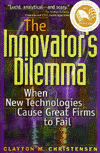Yesterday when I blogged about simplicity I forgot to mention Clayton Christensen‘s take on simple technology. Clayton’s ground-breaking book was entitled "The Innovator’s Dilemma" and is a must-read for any developer who wants to understand the business dynamics between market incumbency and innovative uses of technology.
From his extensive research Christensen states in The Innovator’s Dilemma that disruptive innovations are almost never the result of technological breakthroughs but are instead recombinations of existing and often inexpensive technology in forms the former market leaders don’t pursue. He states the driving reason for the market leaders ignoring disruptive innovations the people in their sales organizations fight against pursuing them because they don’t see big enough market opportunities and/or they can’t make large enough margins compared to their incumbent business. That is, until it’s too late.
Christensen defines disruptive innovations as those "innovations1 that allow small companies to topple once strong, market leading companies and establish themselves as market leaders. His first example was 8" disk drives manufacturers who put out of business all 14" disk drive manufacturers. The latter sold to mainframe vendors at 60% margins, and their customers were interested in larger capacity and faster drives, not in more expensive slower smaller drives with less capacity (which had to be sold at only 40% margins!) But mini-computer manufacturers purchased the 8" disk drives and over time the 8" disk drive manufacturers improved their products to the point of being good enough (key phrase) that mainframe vendors decided to buy from them rather the pay for the increasingly feature rich and increasingly expensive 14" disk drives. At that point, with cost structures requiring 60% margins, the 14" disk drive manufacturers couldn’t maneuver and they all failed.
Examples of recent disruptive innovations with which you might be familiar are:
- Open-source ASP.NET apps and .NET developer tools such as DotNetNuke in the content management space, and NUnit and related for testing tools. Both of these started out much more simple than commercial alternatives, but are evolving.
- Simpler .NET components. Five years ago most components vendors were US-based. Today, the Internet has empowered many vendors outside the US to compete on price alone for the simpler components. One only need look at the number of the vast number of Internet Email Components for .NET to see this trend for what it is.
- Small-project Outsourcing. Another trend near and not-so-dear to many developer’s hearts – outsourcing – is all about being able to offer development services for less. Look at places like RentACoder where you can have small projects developed for literally a tiny fraction of what it would cost to hire a developer in the US to do the same work (smart and entrepreneurial developers should see this as an opportunity rather than a problem…) Today RentACoder’s projects are simple and inexpensive; tomorrow, who knows?
- RSS vs. incredibly fragmented and expensive alternatives to content syndication; RSS is simply XML, after all.
- Wikis, "The simplest thing that could possibly work" according to the Wiki’s inventor Ward Cummingham have edged out many commerical collaboration solutions, and most people say they do it better than what came before.
- MySQL started out as a simple and basic alternative to Oracle, SQL Server, and DB2. When you look at all the people who deployed early versions of MySQL because of its price (optionally free) instead of going with one of the big three, you realized that good enough really was an important concept at play. Now MySQL v5.0 is out and has stored procedures, triggers, views, and more. And if MySQL ever becomes good enough for everybody, Oracle, Microsoft, and IBM can’t compete at their margins.
I could go on, but those should be enough to help you understand the concept if my abstract description wasn’t enough.
Actually, if you think of another example, it would be cool if you would make a comment here and let me and my readers know about it!
1 – Also note that Christensen defined the term "innovation" to encompass a broader scope than just what we think of as technologies. He included business models as innovations too.
